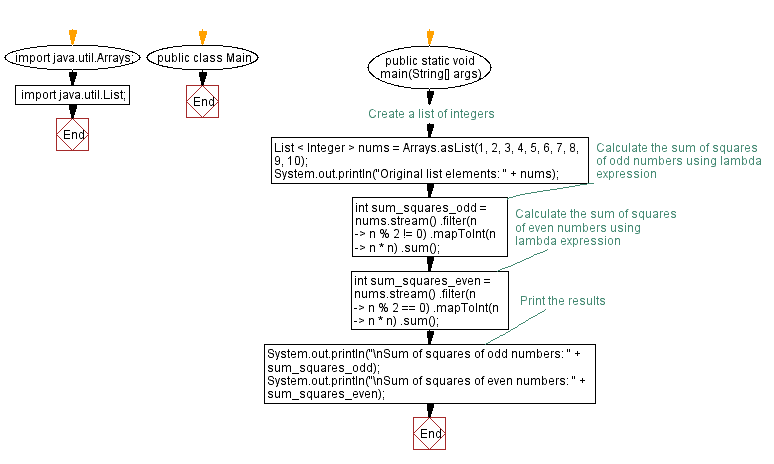Java program to calculate sum of squares of odd and even numbers using lambda expression
15. Sum squares of odd/even numbers using lambda
Write a Java program to implement a lambda expression to calculate the sum of squares of all odd and even numbers in a list.
Sample Solution:
Java Code:
import java.util.Arrays;
import java.util.List;
public class Main {
public static void main(String[] args) {
// Create a list of integers
List < Integer > nums = Arrays.asList(1, 2, 3, 4, 5, 6, 7, 8, 9, 10);
System.out.println("Original list elements: " + nums);
// Calculate the sum of squares of odd numbers using lambda expression
int sum_squares_odd = nums.stream()
.filter(n -> n % 2 != 0)
.mapToInt(n -> n * n)
.sum();
// Calculate the sum of squares of even numbers using lambda expression
int sum_squares_even = nums.stream()
.filter(n -> n % 2 == 0)
.mapToInt(n -> n * n)
.sum();
// Print the results
System.out.println("\nSum of squares of odd numbers: " + sum_squares_odd);
System.out.println("\nSum of squares of even numbers: " + sum_squares_even);
}
}
Sample Output:
Original list elements: [1, 2, 3, 4, 5, 6, 7, 8, 9, 10] Sum of squares of odd numbers: 165 Sum of squares of even numbers: 220
Explanation:
The necessary classes are imported: Arrays and Lists.
In the main method, we create a list of integers called nums using Arrays.asList().
A lambda expression is used to calculate the sum of squares of odd numbers:
- Use the stream() method to create a stream of integers from the nums list.
- Use the filter() method to filter out odd numbers by checking if the remainder of dividing the number by 2 is not equal to 0.
- Use the mapToInt() method to square each odd number.
- Use the sum() method to calculate the sum of squares of odd numbers.
- Store the result in the variable sum_squares_odd.
A similar lambda expression is used to calculate the sum of squares of even numbers:
- Use the filter() method to filter out even numbers by checking if the remainder of dividing the number by 2 is equal to 0.
- Store the result in the variable sum_squares_even.
Finally, System.out.println() function prints the result.
Flowchart:

For more Practice: Solve these Related Problems:
- Write a Java program to implement a lambda expression that calculates the sum of squares of even numbers in a list.
- Write a Java program to create a lambda that computes the sum of squares for odd numbers and even numbers separately.
- Write a Java program to implement a lambda that filters odd numbers, maps them to their squares, and then sums the result.
- Write a Java program to chain lambda expressions that calculate and compare the sum of squares of odd versus even numbers.
Go to:
PREV : Check if string is palindrome using lambda.
NEXT : Check if word exists in list using lambda.
Live Demo:
Java Code Editor:
Improve this sample solution and post your code through Disqus
What is the difficulty level of this exercise?
Test your Programming skills with w3resource's quiz.
